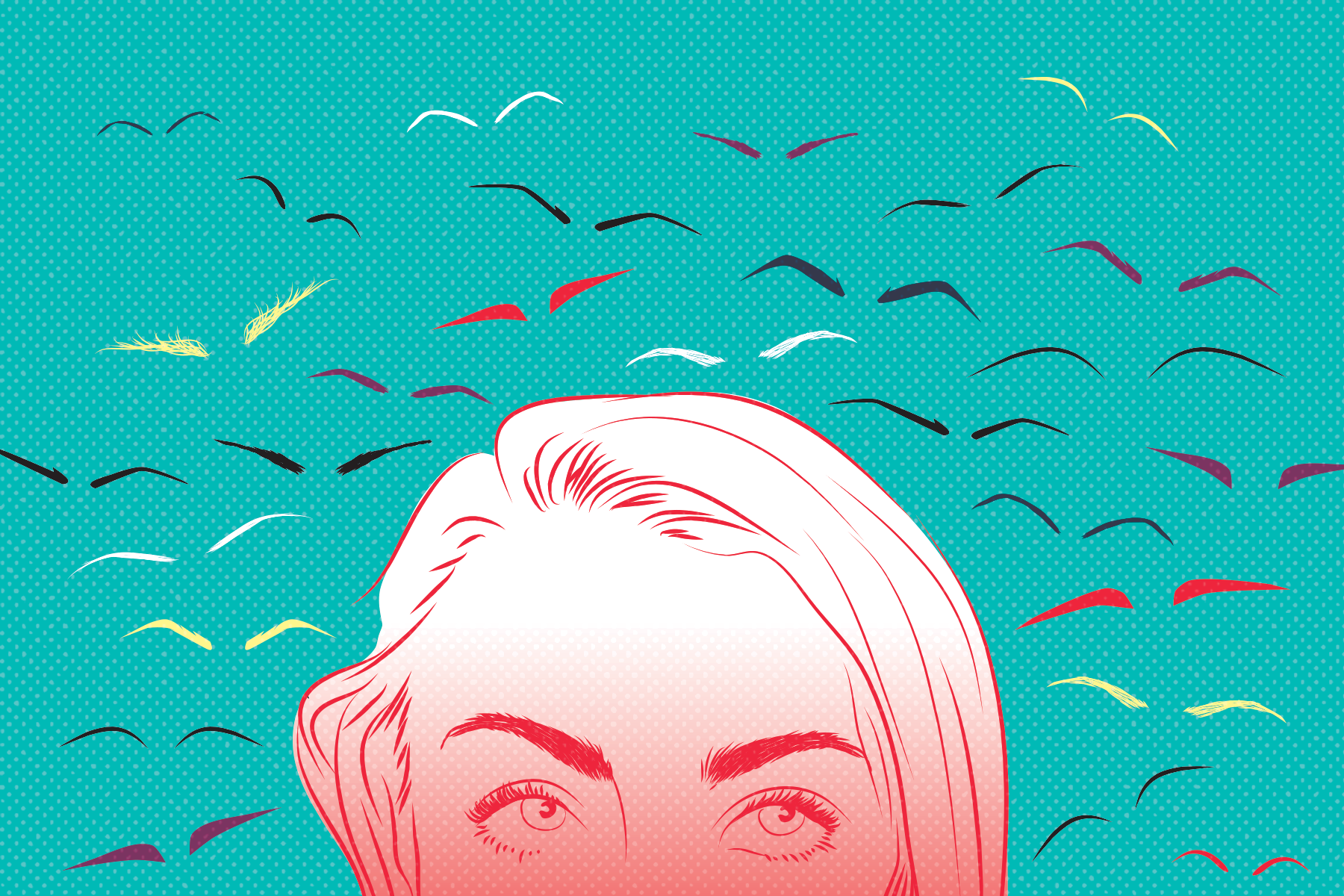#Eyebrowgamestrong has more significance than just bold arches.
by Nicole Garner
illustration by Grace Molteni
Eyebrows have it rough. Those small (or large) tufts of hair have been plucked, shaved, waxed, drawn on and let wild for nearly all of human existence. They’ve sometimes even been covered with bushy adhesive facial wigs — an ancient trend that’s making a resurgence, by the way.
Modifying eyebrows for beauty and social significance isn’t new in the slightest — not even beyond 100 years ago. Millions of ancient women and men were pulling some #eyebrowgamestrong before Instagraming their perfected arches (or lack thereof) was even an option, all in an effort to display their social significance and hierarchy.
Social researcher Victoria Sherrow describes in her book, For Appearance’ Sake: The Historical Encyclopedia of Good Looks, Beauty, and Grooming, the countless ways eyebrows were historically used to suggest class affiliation. In Japan between 794 and 1185, upper class nobility would remove their brows only to draw new ones on higher. Centuries later, Japanese women would use their eyebrow designs to show their marriage and childbearing status.
Egyptian women mimicked Cleopatra’s defined brows with added color. Sharrow describes how Ancient Greeks used eyebrow wigs made of goat hair to create stronger brows, while European women in the Elizabethan era opted to entirely shave and draw on new brows to match Queen Elizabeth I’s noble vibe.
Within the past 10 years, eyebrows have even been used to identify gang members; news stories suggested that shaved eyebrows showed off gang involvement.
The love-hate relationship brow aficionados have with their facial hair often has roots in the eyebrow’s most important job (beyond conveying emotion): silently sharing cultural and group affiliations, whether realized or not. Just like clothes and accessories, eyebrows are another way of shaping the impression of our social standing.
Think about it: Western culture often correlates well-groomed body hair with the beautiful, successful and wealthy (getting salon-styled brows is not cheap), sometimes consciously, other times, not at all. But the infamous unibrow or unkempt eyebrow is the laughingstock of body hair — think Ugly Betty-style brows, which were “fixed” to show a new and improved version of the character. The owner of bushy brows silently tells others that they don’t have the social prowess, financial resources or desire to put them in place. Beauty commentators have even suggested that brows can reflect their owner’s hometown or region based on shape and size.
Given this, why has there been so much recent hype about thick, feathered brows, which are less reined in and refined than their precisely plucked counterparts?
The newest eyebrow phase is more encompassing without meaning to be. Model Cara Delevingne’s lush eyebrow preference, a throwback to the iconic 1980s Brooke Shields brow, is now touted by Kardashians and Kansas-bred girls alike. It’s possible that the return to a thicker eyebrow has gained new life 20-plus years later because of timing: when other natural beauty trends such as minimal-makeup and natural hair are excelling, a more natural brow seems on par.
Individuals with the thickest of brows can get behind a trend that doesn’t require hours with tweezers and a mirror in hand, or costly monthly trips to the salon, instead suggesting that what’s unique to your face is just right. That thought — that natural is ok — might reprogram our social cues to “accept” less-than-perfect brows; it’s unfortunately easy to subconsciously judge the owners of bushier brows based on current beauty standards while tossing aside other factors, such as religious convictions or differing cultural norms.
Social researcher Anne Sofie Roald discusses in her book, Women in Islam: The Western Experience, the religious prohibition of eyebrow plucking for Muslim women (a quick web search prompts countless blogs and forums where Muslim women discuss which eyebrow grooming habits should and shouldn’t be allowed). And for Sikh women, another religious group that aims to maintain natural bodily features, keeping up with Western beauty trends while adhering to religious tenets can be a struggle (as outlined by social scientist Rosemary Skinner Keller in her Encyclopedia of Women and Religion in North America).
Could a shift in thinking about brows and natural body hair lead Westerners to become more open to a “less primped” look, regardless of whose face it appears on? Could a move toward more apparent and natural body hair even lead to an acceptance of other (stereotypically less-feminine) body hair? Research shows no, but it’s an intriguing thought.
The potential irony in this approach to bold, natural brows is that it isn’t natural for everyone. Eyebrow extensions, fillers and dyes are now becoming featured beauty products, so much that they’re now a noticeable moneymaker in the cosmetics industry.
In fact, it’s becoming difficult to find a beauty publication that celebrates differing brow styles. Articles that do herald an alternative to the Cara D. eyebrow, such as the Korean straight brow, still display a relatively bold approach to facial hair compared to the thin structure of the 2000s.
Perhaps participating in the currently trending Instagram and Twitter brow selfies allows women with voluminous brows to share in a new cultural convention of sorts.
Eyebrows, formerly a symbol of social status, might now be interpreted as something else—perhaps, that there’s nothing wrong with playing up natural attributes instead of plucking them in an effort to fit in. It’s like saying, we’re all different, but the same — you, me and our strong brows.
[hr style=”striped”]
Nicole Garner is a freelance writer and a contributor for The Riveter. Follow her @nlgarner.
Grace Molteni is a Midwest born and raised designer, illustrator, and self-proclaimed bibliophile, currently calling Chicago home. For more musings, work, or just to say hey check her out on Instagram or at her personal website.




